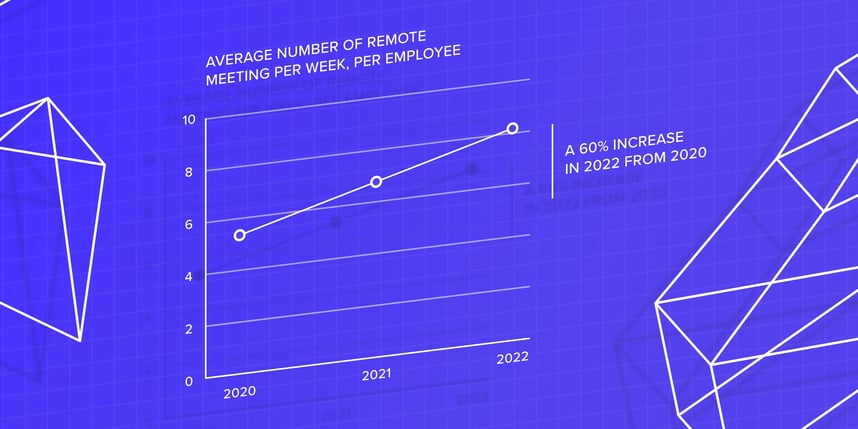Hybrid Work and Your Teams: Is Employee Engagement Really an Issue?
Pre-2020, or the pre-hybrid era, as many employers might like to refer to it, was a different time in work. Most employees worked from the office in many industries, and the 9-5 workday was standard for most professionals.
Enter 2023, where we can expect many organizations to begin to define a new normal for hybrid and remote employees through policies that aim to keep a remote workforce engaged, while meeting business needs. Understanding employee engagement through measurable, evidence-based methods is more important than ever.
Remote collaboration is evolving
In 2022, a Harvard Business Review study showed that teams are having more meetings than ever. The number of meetings has increased by 60% since the pre-pandemic era, and remote employees are connecting often via virtual meetings. This doesn't point to a lack of engagement; it points to highly engaged employees, and the strengths of new communication tools to ensure remote workers feel engaged and connected to their teams.

Meetings and employee engagement
The Harvard Business Review also notes that online meetings are beginning to mimic the way employees interacted pre-2020, with smaller, more intimate online meetings taking the place of large Zoom calls, and the duration of meeting shortening, which means people are hopping on calls to talk about smaller things in one-on-one meetings, which they might of done before by walking over to someone's desk. To engage remote teams, ensuring the range of communication tools available are user-friendly and impactful is an important part of ensuring team progress.
This research points to informal communication taken through shared communication channels between remote workers and those in the office. This doesn't point to less engaged employees; quite the opposite. It demonstrates that there are many ways for team members to connect while working remotely, and that company culture may be a tacit trait of organizations, still in place despite major disruptions to work over the past three years. New hires joining in a hybrid work environment can easily slot themselves into these office norms.
Performance metrics versus engagement versus the 9-5
Economic conditions aside, if you want to ensure your business can perform with as much impact in 2023 as it did in 2020 when it comes to the work your teams do, then you will have to look beyond the old bums in seats metrics of engagement and find ways to measure performance in new ways.
From The Harvard Business Review:
"...performative face time is not novel to remote work. Prior to Covid-19, office workers, at times when they had no work available to do, still felt forced to spend hours in the office idly each week pretending to be busy for purposes of appearances."
In a time of quiet quitting and major changes to the very nature of work, isn't it more important to measure your teams' contributions to your organization, versus their attendance record?
Flexible schedules as a retention tool
Employee morale and engagement is a crucial part of retaining employees. When employees feel trusted, when company culture finds ways for them to stay connected while retaining a better work life balance than they did pre-pandemic, organizations can honor employee well-being as a central component of company culture. Job satisfaction is an important part of retention, and a company's culture.
Trusting your virtual teams and their commitments to your organization, presuming there have been no challenges with performance, is an important component of leadership in this time. Insisting team members come back to the office for an arbitrary amount of time each week may foster a rift in employee engagement and morale that could create serious challenges for your organization, and may not contribute to employee engagement, even if it is the intention.

Hybrid work is simply work
Remote employees are employees. A remote team is a team. Virtual meetings are meetings. A remote workforce is a workforce, crucial to your success as an organization. 2023, for many workplaces will be the year where remote work becomes simply work. Creating policies and making data-driven decisions to accommodate that will support work life balance, employee engagement.
Keeping employees engaged can take many forms, regardless as to if they're a remote employee, or a hybrid one, or spending most of their time in the office. Micromanaging the way they work is not one of them.
If employees are engaged, and your organization is doing impactful work, then you're doing many things right, even if things may not look the same around your office space as they did in early 2020.
Supporting engagement in your organization
Hybrid and remote work are here to stay; is your office environment ready for this shift? Are your spaces and systems best set up to host virtual meetings, to do video conferencing internally and externally, and ensure that you're ready to move forward with a new plan?
Thinking about remote workers as members of your team, the same as any others means considering how they can remain engaged employees, with the ability to interact, meet, collaborate, and engage with their colleagues from home. This may mean additional spaces for virtual meetings, coming up with ways to celebrate employee accomplishments that aren't an in-person recognition, and ensuring that career growth opportunities aren't prioritized for those who show more face time. Keeping remote workers engaged is a challenge, but studies show remote work also contributes to positive work life balance and employee satisfaction, so the effort is well-worth it
InnerSpace can help you understand how your space is being used, and where and when your teams are engaging in work on site, which can help you support your entire team. This including those who are working remotely, by ensuring everyone can participate in office culture in-person and virtually.
Move forward with evidence-based spatial analysis

The benefits of prioritizing and fostering engagement over the traditional 9-5 schedule can help your organization thrive in a changing time. Are you ready to embrace work at your organization and ensure your space is ready to meet the shifts to come? We'd love to talk #indoorology with you and how it can support your office's transition from hybrid work to business as usual.
Accurate space utilization data through Wi-Fi?
We'll prove it to you.
See why industry leaders leverage InnerSpace to generate valuable insights that go beyond occupancy.

